| Demographics of Wales | |
|---|---|
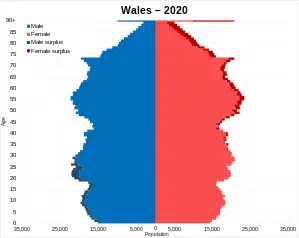 Population pyramid of Wales in 2020 | |
| Population | 3,107,500 |
| Fertility rate | 1.48 |
Demographics of Wales include the numbers in population, place of birth, age, ethnicity, religion, and number of marriages in Wales.
Historical population
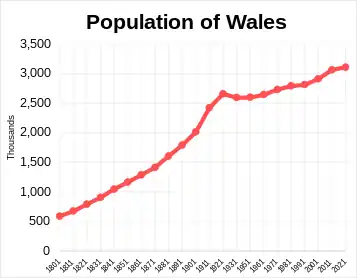
| Year | Pop. | ±% |
|---|---|---|
| 1801 | 587,128 | — |
| 1811 | 673,337 | +14.7% |
| 1821 | 789,271 | +17.2% |
| 1831 | 904,312 | +14.6% |
| 1841 | 1,045,958 | +15.7% |
| 1851 | 1,163,139 | +11.2% |
| 1861 | 1,286,413 | +10.6% |
| 1871 | 1,412,583 | +9.8% |
| 1881 | 1,604,821 | +13.6% |
| 1891 | 1,788,639 | +11.5% |
| 1901 | 2,012,876 | +12.5% |
| 1911 | 2,420,921 | +20.3% |
| 1921 | 2,656,474 | +9.7% |
| 1931 | 2,593,332 | −2.4% |
| 1951 | 2,596,850 | +0.1% |
| 1961 | 2,644,023 | +1.8% |
| 1971 | 2,731,204 | +3.3% |
| 1981 | 2,790,500 | +2.2% |
| 1991 | 2,811,865 | +0.8% |
| 2001 | 2,910,200 | +3.5% |
| 2011 | 3,063,456 | +5.3% |
| 2021 | 3,107,500 | +1.4% |
| Source: [1] [2] | ||
| Year | Population[3][4] |
| 1536 | 278,000 |
| 1620 | 360,000 |
| 1770 | 500,000 |
| 1801 | 587,000 |
| 1851 | 1,163,000 |
| 1911 | 2,421,000 |
| 1921 | 2,656,000 |
| 1939 | 2,487,000 |
| 1961 | 2,644,023 |
| 1991 | 2,811,865 |
| 2011 | 3,063,456 |
| 2021 | 3,107,500 |
The population of Wales doubled from 587,000 in 1801 to 1,163,000 in 1851 and had reached 2,421,000 by 1911. Most of the increase came in the coal mining districts especially Glamorganshire, which grew from 71,000 in 1801 to 232,000 in 1851 and 1,122,000 in 1911.[5] Part of this increase can be attributed to the demographic transition seen in most industrialising countries during the Industrial Revolution, as death-rates dropped and birth-rates remained steady. However, there was also a large-scale migration of people into Wales during the industrial revolution.
Current population
The 2021 census showed Wales' population to be 3,107,500, the highest in its history.[6] In 2011, 27 per cent (837,000) of the total population of Wales were not born in Wales,[7][8] including 636,000 people (21 per cent of the total population of Wales) who were born in England.[9] The main population and industrial areas are in south Wales, including the cities of Cardiff, Swansea and Newport and the nearby valleys, with another significant population in the north-east around Wrexham and Flintshire.

According to the 2001 census, 96 per cent of the population was White British, and 2.1 per cent non-white (mainly of British Asian origin).[10] Most non-white groups were concentrated in Cardiff, Newport and Swansea. Welsh Asian and African communities developed mainly through immigration after the Second World War.[11] In the early 21st century, parts of Wales saw an increased number of immigrants settle from recent EU accession countries such as Poland;[12] though a 2007 study showed a relatively low number of employed immigrant workers from the former Eastern Bloc countries in Wales compared to other regions of the United Kingdom.[13]
The 2001 UK census was criticised in Wales for not offering 'Welsh' as an option to describe respondents' national identity.[14] Partly to address this concern, the 2011 census asked the question "How would you describe your national identity?". Respondents were instructed to "tick all that apply" from a list of options that included Welsh. The outcome was that 57.5 per cent of Wales' population indicated their sole national identity to be Welsh; a further 7.1 per cent indicated it to be both Welsh and British. No Welsh national identity was indicated by 34.1 per cent. The proportion giving their sole national identity as British was 16.9 per cent, and another 9.4 per cent included British with another national identity. No British national identity was indicated by 73.7 per cent. 11.2 per cent indicated their sole national identity as English and another 2.6 per cent included English with another national identity.[15][16][17]
The 2011 census showed Wales to be less ethnically diverse than any region of 'England and Wales':[18] 93.2 per cent classed themselves as White British (including Welsh, English, Scottish or Northern Irish), 2.4 per cent as "Other White" (including Irish), 2.2 per cent as Asian (including Asian British), 1 per cent as Mixed, and 0.6 per cent as Black (African, Caribbean, or Black British). The lowest proportion of White British (80.3 per cent) was in Cardiff.[17][19]
In 2001, a quarter of the Welsh population were born outside Wales, mainly in England; about 3 per cent were born outside the UK. The proportion born in Wales varies across the country, with the highest percentages in the south Wales valleys and the lowest in mid Wales and parts of the north-east. In both Blaenau Gwent and Merthyr Tydfil, 92 per cent were Welsh-born, compared with only 51 per cent and 56 per cent in the border counties of Flintshire and Powys.[20] Just over 1.75 million Americans report themselves to have Welsh ancestry, as did 440,965 Canadians in Canada's 2006 census.[21][22]
The total fertility rate (TFR) in Wales was 1.90 in 2011,[23] which is below the replacement rate of 2.1. The majority of births are to unmarried women (58 per cent of births in 2011 were outside marriage).[24] About one in 10 births (10.7 per cent) in 2011 were to foreign-born mothers, compared to 5.2 per cent in 2001.[25]
| Rank | Name | Council area | Pop. | Rank | Name | Council area | Pop. | ||
|---|---|---|---|---|---|---|---|---|---|
 Cardiff  Swansea |
1 | Cardiff | City & County of Cardiff | 335,145 | 11 | Caerphilly | Caerphilly County Borough | 41,402 |  Newport  Wrexham |
| 2 | Swansea | City & County of Swansea | 239,000 | 12 | Port Talbot | Neath Port Talbot | 37,276 | ||
| 3 | Newport | Newport City | 128,060 | 13 | Pontypridd | Rhondda Cynon Taf | 30,457 | ||
| 4 | Wrexham | Wrexham County Borough | 61,603 | 14 | Aberdare | Rhondda Cynon Taf | 29,748 | ||
| 5 | Barry | Vale of Glamorgan | 54,673 | 15 | Colwyn Bay | Conwy County Borough | 29,405 | ||
| 6 | Neath | Neath Port Talbot | 50,658 | 16 | Pontypool | Torfaen | 28,334 | ||
| 7 | Cwmbran | Torfaen | 46,915 | 17 | Penarth | Vale of Glamorgan | 27,226 | ||
| 8 | Bridgend | Bridgend County Borough | 46,757 | 18 | Rhyl | Denbighshire | 25,149 | ||
| 9 | Llanelli | Carmarthenshire | 43,878 | 19 | Blackwood | Caerphilly County Borough | 24,042 | ||
| 10 | Merthyr Tydfil | Merthyr Tydfil | 43,820 | 20 | Maesteg | Bridgend County Borough | 18,888 | ||
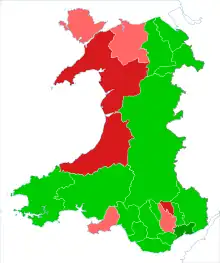
Vital statistics
| Average population | Live births | Deaths | Natural change | Crude birth rate (per 1000) | Crude death rate (per 1000) | Natural change (per 1000) | Fertility rates | |
|---|---|---|---|---|---|---|---|---|
| 1940 | 39,319 | 35,585 | 3,734 | 13.9 | 12.6 | 1.3 | 1.84 | |
| 1941 | 39,886 | 35,837 | 4,049 | 13.7 | 12.3 | 1.4 | 1.82 | |
| 1942 | 43,130 | 31,360 | 11,770 | 15.4 | 11.2 | 4.2 | 2.03 | |
| 1943 | 43,270 | 31,496 | 11,774 | 16.0 | 11.6 | 4.4 | 2.11 | |
| 1944 | 46,730 | 30,987 | 15,743 | 17.5 | 11.6 | 5.9 | 2.33 | |
| 1945 | 41,515 | 31,892 | 9,623 | 15.7 | 12.1 | 3.6 | 2.12 | |
| 1946 | 47,566 | 31,547 | 16,019 | 19.0 | 12.3 | 6.7 | 2.55 | |
| 1947 | 51,163 | 33,291 | 17,872 | 20.4 | 13.3 | 7.1 | 2.75 | |
| 1948 | 47,175 | 30,095 | 17,080 | 17.7 | 11.3 | 6.4 | 2.46 | |
| 1949 | 44,337 | 32,109 | 12,228 | 16.6 | 12.0 | 4.6 | 2.35 | |
| 1950 | 42,776 | 33,295 | 9,481 | 15.4 | 12.9 | 2.5 | 2.26 | |
| 1951 | 41,270 | 36,005 | 5,265 | 15.2 | 13.3 | 1.9 | 2.21 | |
| 1952 | 41,388 | 31,005 | 10,383 | 15.1 | 11.3 | 3.8 | 2.23 | |
| 1953 | 41,528 | 31,392 | 10,136 | 15.3 | 12.4 | 2.9 | 2.31 | |
| 1954 | 40,256 | 32,822 | 7,704 | 15.0 | 12.3 | 2.7 | 2.28 | |
| 1955 | 38,876 | 33,938 | 4,938 | 14.8 | 12.7 | 2.1 | 2.25 | |
| 1956 | 40,915 | 32,438 | 8,477 | 15.5 | 12.0 | 3.5 | 2.41 | |
| 1957 | 41,645 | 32,696 | 8,949 | 15.9 | 12.3 | 3.6 | 2.43 | |
| 1958 | 42,460 | 32,642 | 9,818 | 16.2 | 12.2 | 4.0 | 2.50 | |
| 1959 | 42,262 | 32,134 | 10,128 | 16.3 | 12.1 | 4.2 | 2.56 | |
| 1960 | 44,147 | 32,715 | 11,432 | 17.0 | 12.3 | 4.7 | 2.68 | |
| 1961 | 44,923 | 33,705 | 11,218 | 17.4 | 12.9 | 4.5 | 2.75 | |
| 1962 | 45,382 | 33,781 | 11,601 | 17.8 | 13.0 | 4.8 | 2.83 | |
| 1963 | 47,038 | 34,763 | 12,275 | 18.0 | 13.2 | 4.8 | 2.95 | |
| 1964 | 47,502 | 32,746 | 14,756 | 18.3 | 12.3 | 6.0 | 2.99 | |
| 1965 | 46,292 | 33,062 | 13,230 | 17.9 | 12.4 | 5.5 | 2.91 | |
| 1966 | 44,866 | 34,643 | 10,223 | 17.5 | 12.8 | 4.7 | 2.81 | |
| 1967 | 43,706 | 33,160 | 10,546 | 17.0 | 12.2 | 4.8 | 2.73 | |
| 1968 | 44,207 | 34,892 | 9,315 | 16.7 | 12.9 | 3.8 | 2.62 | |
| 1969 | 43,082 | 35,953 | 7,129 | 16.2 | 13.5 | 2.7 | 2.53 | |
| 1970 | 42,487 | 34,998 | 7,489 | 15.8 | 12.8 | 3.0 | 2.47 | |
| 1971 | 2,740,000 | 43,056 | 34,817 | 8,239 | 15.7 | 12.5 | 3.0 | 2.45 |
| 1972 | 2,755,000 | 39,955 | 36,000 | 3,955 | 14.5 | 13.1 | 1.4 | 2.24 |
| 1973 | 2,772,000 | 37,597 | 35,826 | 1,771 | 13.6 | 12.9 | 0.7 | 2.08 |
| 1974 | 2,785,000 | 36,206 | 35,634 | 572 | 13.0 | 12.8 | 0.2 | 1.97 |
| 1975 | 2,795,000 | 33,972 | 35,610 | -1,638 | 12.2 | 12.7 | -0.5 | 1.87 |
| 1976 | 2,799,000 | 33,738 | 36,345 | -2,607 | 11.9 | 13.0 | -1.1 | 1.79 |
| 1977 | 2,800,000 | 31,765 | 35,205 | -3,440 | 11.3 | 12.6 | -1.3 | 1.72 |
| 1978 | 2,804,000 | 33,308 | 35,963 | -2,665 | 11.9 | 12.8 | -0.9 | 1.79 |
| 1979 | 2,810,000 | 36,174 | 36,087 | 87 | 12.9 | 12.8 | 0.1 | 1.91 |
| 1980 | 2,815,000 | 37,357 | 35,149 | 2,208 | 13.3 | 12.5 | 0.8 | 1.95 |
| 1981 | 2,813,000 | 35,842 | 35,015 | 827 | 12.7 | 12.4 | 0.3 | 1.87 |
| 1982 | 2,804,000 | 35,720 | 35,152 | 568 | 12.7 | 12.5 | 0.2 | 1.86 |
| 1983 | 2,803,000 | 35,494 | 35,242 | 252 | 12.7 | 12.6 | 0.1 | 1.83 |
| 1984 | 2,800,000 | 35,861 | 33,652 | 2,209 | 12.8 | 12.0 | 0.8 | 1.83 |
| 1985 | 2,803,000 | 36,771 | 35,536 | 1,235 | 13.1 | 12.7 | 0.4 | 1.86 |
| 1986 | 2,811,000 | 37,038 | 34,712 | 2,326 | 13.2 | 12.3 | 0.9 | 1.86 |
| 1987 | 2,822,000 | 37,816 | 33,919 | 3,897 | 13.4 | 12.0 | 1.4 | 1.88 |
| 1988 | 2,841,000 | 38,824 | 33,981 | 4,842 | 13.7 | 12.0 | 1.7 | 1.91 |
| 1989 | 2,855,000 | 38,019 | 35,134 | 2,885 | 13.3 | 12.3 | 1.0 | 1.86 |
| 1990 | 2,861,000 | 38,866 | 33,963 | 4,903 | 13.6 | 11.9 | 1.7 | 1.91 |
| 1991 | 2,873,000 | 38,079 | 34,136 | 3,943 | 13.3 | 11.9 | 1.4 | 1.88 |
| 1992 | 2,877,000 | 37,523 | 33,792 | 3,731 | 13.0 | 11.7 | 1.3 | 1.87 |
| 1993 | 2,883,000 | 36,578 | 35,826 | 752 | 12.7 | 12.4 | 0.3 | 1.84 |
| 1994 | 2,887,000 | 35,366 | 33,824 | 1,542 | 12.2 | 11.7 | 0.5 | 1.79 |
| 1995 | 2,888,000 | 34,477 | 35,306 | -829 | 11.9 | 12.2 | -0.3 | 1.77 |
| 1996 | 2,891,000 | 34,894 | 34,802 | 92 | 12.1 | 12.0 | 0.1 | 1.81 |
| 1997 | 2,895,000 | 34,520 | 34,886 | -366 | 11.9 | 12.1 | -0.2 | 1.81 |
| 1998 | 2,899,000 | 33,438 | 33,905 | -467 | 11.5 | 11.7 | -0.2 | 1.78 |
| 1999 | 2,900,000 | 32,111 | 34,929 | -2,818 | 11.1 | 12.0 | -0.9 | 1.72 |
| 2000 | 2,907,000 | 31,304 | 33,501 | -2,197 | 10.8 | 11.5 | -0.7 | 1.68 |
| 2001 | 2,910,000 | 30,616 | 33,249 | -2,633 | 10.5 | 11.4 | -0.9 | 1.66 |
| 2002 | 2,923,000 | 30,205 | 33,314 | -3,108 | 10.3 | 11.4 | -1.1 | 1.64 |
| 2003 | 2,937,000 | 31,400 | 33,810 | -2,410 | 10.7 | 11.5 | -0.8 | 1.71 |
| 2004 | 2,957,000 | 32,325 | 32,317 | 8 | 10.9 | 10.9 | 0.0 | 1.76 |
| 2005 | 2,969,000 | 32,593 | 32,162 | 431 | 11.0 | 10.8 | 0.2 | 1.78 |
| 2006 | 2,985,000 | 33,628 | 31,083 | 2,545 | 11.3 | 10.4 | 1.1 | 1.82 |
| 2007 | 3,006,000 | 34,414 | 32,148 | 2,266 | 11.4 | 10.7 | 0.7 | 1.86 |
| 2008 | 3,026,000 | 35,650 | 32,066 | 3,584 | 11.8 | 10.6 | 1.2 | 1.91 |
| 2009 | 3,039,000 | 34,937 | 31,066 | 3,871 | 11.5 | 10.2 | 1.3 | 1.87 |
| 2010 | 3,050,000 | 35,952 | 31,197 | 4,755 | 11.8 | 10.2 | 1.6 | 1.92 |
| 2011 | 3,063,000 | 35,598 | 30,426 | 5,172 | 11.6 | 9.9 | 1.7 | 1.90 |
| 2012 | 3,074,000 | 35,238 | 31,502 | 3,736 | 11.5 | 10.2 | 1.3 | 1.88 |
| 2013 | 3,082,000 | 33,747 | 32,138 | 1,609 | 10.9 | 10.4 | 0.5 | 1.80 |
| 2014 | 3,092,000 | 33,544 | 31,439 | 2,105 | 10.8 | 10.2 | 0.6 | 1.78 |
| 2015 | 3,099,000 | 33,279 | 33,198 | 81 | 10.7 | 10.7 | 0.0 | 1.77 |
| 2016 | 3,113,000 | 32,936 | 33,047 | –111 | 10.6 | 10.6 | –0.0 | 1.74 |
| 2017 | 3,125,000 | 32,176 | 33,248 | −1,072 | 10.4 | 10.6 | −0.2 | 1.69 |
| 2018 | 3,139,000 | 31,274 | 34,406 | –3,132 | 10.0 | 11.0 | –1.0 | 1.63 |
| 2019 | 3,153,000 | 29,704 | 32,900 | -3,196 | 9.4 | 10.4 | -1.0 | 1.54 |
| 2020 | 3,170,000 | 28,638 | 37,399 | -8,761 | 9.0 | 11.8 | -2.8 | 1.47 |
| 2021(c) | 3,107,500 | 28,781 | 36,141 | -7,360 | 9.3 | 11.6 | -2.3 | 1.51 |
| 2022 | 3,131,640 | 28,296 | 35,688 | -7,392 | 9.1 | 11.4 | -2.3 | |
(c) = Census results.
Current vital statistics
| Period | Live births | Deaths | Natural increase |
|---|---|---|---|
| January - November 2022 | 32,264 | ||
| January - November 2023 | 33,166 | ||
| Difference |
Place of birth
According to the 2011 census 2.2 million (73%) of the usual residents were born in Wales, a reduction of two percent since 2001. In 2001, 590,000 (20%) of the population of Wales was born in England. By 2011, the proportion of English-born citizens of Wales had increased by one percent to 21%. In 2011, 27% (837,000) of the total population of Wales were born outside Wales, and of these immigrants 636,000 (76%) were born in England.[30]
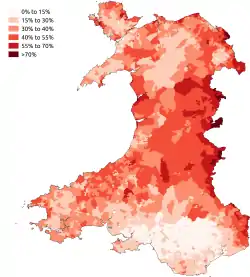
| Country of birth | 2001[31] | 2011[32] | ||
|---|---|---|---|---|
| Number | % | Number | % | |
| 2,188,754 | 75.39% | 2,226,005 | 72.66% | |
| 589,828 | 20.32% | 636,266 | 20.77% | |
| 24,389 | 0.84% | 24,346 | 0.79% | |
| 7,851 | 0.27% | 8,253 | 0.27% | |
| 715 | 0.02% | |||
| 12,718 | 0.44% | 12,175 | 0.40% | |
| Other |
23,694 | 0.82% | 55,360 | 1.81% |
| Other |
26,343 | 0.86% | ||
| Other |
29,017 | 0.95% | ||
| Other countries | 55,851 | 1.92% | 100,336 | 3.28% |
| Total | 2,903,085 | 100.00% | 3,063,456 | 100.00% |
Below are the 5 largest foreign-born groups in Wales according to 2014 ONS estimates.[33]
| Country of birth | Estimated population | ||
|---|---|---|---|
| 2013 | 2014 | 2015 | |
| 20,000 | 22,000 | 23,000 | |
| 11,000 | 12,000 | 10,000 | |
| 10,000 | 12,000 | 13,000 | |
| 11,000 | 11,000 | 11,000 | |
| 7,000 | 6,000 | 6,000 | |
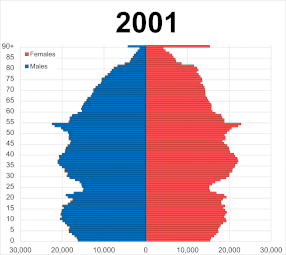
Age

According to the 2011 census, some 563,000 of the population were aged 65 and over, an increase of 56,700 or one percent since 2001. As in 2001, six per cent (178,000) of the population in Wales were children under five, an increase of 11,300.[32]
| Ages attained (years) |
Population | % of total |
|---|---|---|
| 0–4 | 178,301 | 5.82 |
| 5–9 | 163,079 | 5.32 |
| 10–14 | 177,748 | 5.80 |
| 15–19 | 199,120 | 6.50 |
| 20–24 | 211,924 | 6.92 |
| 25–29 | 185,728 | 6.06 |
| 30–34 | 174,694 | 5.70 |
| 35–39 | 183,045 | 5.98 |
| 40–44 | 213,155 | 6.96 |
| 45–49 | 213,155 | 7.20 |
| 50–54 | 201,599 | 6.58 |
| 55–59 | 186,923 | 6.10 |
| 60–64 | 204,885 | 6.69 |
| 65–69 | 166,007 | 5.42 |
| 70–74 | 134,543 | 4.39 |
| 75–79 | 108,202 | 3.53 |
| 80–84 | 79,232 | 2.59 |
| 85–89 | 49,360 | 1.61 |
| 90+ | 25,200 | 0.82 |
National identity
2011
A question on national identity was asked in the 2011 census: "What do you feel is your national identity?" Respondents could identify themselves as having one or more national identity.
An analysis of the 2011 data by Manchester University's Centre on Dynamics of Ethnicity revealed that:[34]
- 58% identified as "Welsh only"
- 16% identified as "British only"
- 12% identified as "English only"
- 7% identified as "Welsh and British"
The remainder chose other national identities. (Percentiles are majoritively shown.) The Welsh-Caribbean population were the most likely to respond as "Welsh Only", at 59% of 11,099 citizens.
2018
A 2018 poll, commissioned by the BBC and carried out by YouGov, found that almost eight in 10 (79%) people in Wales identified strongly as British; while six in 10 (62%) identified strongly as Welsh.[35][36]
2020
A 2020 YouGov poll asking a sample of 1110 people "Which, if any, of the following best describes the way you think of yourself?" found the following responses:
- 21% "Welsh not British"
- 17% "More Welsh than British"
- 22% "Equally Welsh and British"
- 9% "More British than Welsh"
- 17% "British not Welsh"
- 11% "Other"
- 3% "Don't know"
Summary
Total Welsh at all: 69%
Total at least more Welsh than British: 38%
Total at least more British than Welsh: 26%[37]
Ethnicity



According to the 2011 census, 2.2 million (73%) of usual residents of Wales were born there, two percent less than in 2001. The change can be attributed to both international and internal migration. In 2001, 590,000 (20%) of the population of Wales was born in England. In 2011, this had increased by one percent.[32] Nearly 418,000 people identified themselves as Welsh in 2001. The 1991, 2001 and 2011 census estimated the following ethnic groups:
| Ethnic group | Year | |||||||||
|---|---|---|---|---|---|---|---|---|---|---|
| 1981 estimations[39] | 1991[40][41] | 2001[42] | 2011[43] | 2021[44] | ||||||
| Population | % | Population | % | Population | % | Population | % | Population | % | |
| White: Total | 2,788,533 | 99.1% | 2,793,522 | 98.5% | 2,841,505 | 97.9% | 2,928,253 |
95.6% |
2,915,848 | 94.2% |
| White: British | – | – | – | – | 2,786,605 | 96.0% | 2,855,450 | 93.2% | 2,814,427 | 90.9% |
| White: Irish | – | – | 20,841 | 0.7% | 17,689 | 0.6% | 14,086 | 0.5% | 13,214 | 0.4% |
| White: Irish Traveller/White Gypsy[note 1] | – | – | – | – | – | – | 2,785 | 0.1% | 3,550 | 0.1% |
| White: Roma | – | – | – | – | – | – | – | – | 1,843 | 0.1% |
| White: Other | – | – | – | – | 37,211 | 1.3% | 55,932 | 1.8% | 82,994 | 2.7% |
| Asian or Asian British: Total | – | – | 24,399 | 0.9% | 31,715 | 1.1% | 70,128 |
2.3% |
89,028 | 3% |
| Asian or Asian British: Indian | – | – | 6,384 | 0.2% | 8,261 | 0.3% | 17,256 | 0.6% | 21,070 | 0.7% |
| Asian or Asian British: Pakistani | – | – | 5,717 | 0.2% | 8,287 | 0.3% | 12,229 | 0.4% | 17,534 | 0.6% |
| Asian or Asian British: Bangladeshi | – | – | 3,820 | 0.1% | 5,436 | 0.2% | 10,687 | 0.3% | 15,314 | 0.5% |
| Asian or Asian British: Chinese[note 2] | – | – | 4,801 | 0.2% | 6,267 | 0.2% | 13,638 | 0.4% | 14,454 | 0.5% |
| Asian or Asian British: Asian Other | – | – | 3,677 | 0.1% | 3,464 | 0.1% | 16,318 | 0.5% | 20,656 | 0.7% |
| Black or Black British: Total | – | – | 9,492 | 0.3% | 7,069 | 0.2% | 18,276 |
0.6% |
27,554 | 0.8% |
| Black or Black British: African | – | – | 2,671 | 0.1% | 3,727 | 0.1% | 11,887 | 0.4% | 19,907 | 0.6% |
| Black or Black British: Caribbean | – | – | 3,348 | 0.1% | 2,597 | 0.1% | 3,809 | 0.1% | 3,700 | 0.1% |
| Black or Black British: Other | – | – | 3,473 | 0.1% | 745 | <0.1% | 2,580 | 0.1% | 3,947 | 0.1% |
| British Mixed: Total | – | – | – | – | 17,661 | 0.7% | 31,521 |
1.0% |
48,598 | 1.6% |
| Mixed: White and Caribbean | – | – | – | – | 5,996 | 0.2% | 11,099 | 0.4% | 13,732 | 0.4% |
| Mixed: White and African | – | – | – | – | 2,413 | 0.1% | 4,424 | 0.1% | 8,068 | 0.3% |
| Mixed: White and Asian | – | – | – | – | 5,001 | 0.2% | 9,019 | 0.3% | 14,035 | 0.5% |
| Mixed: Other Mixed | – | – | – | – | 4,251 | 0.2% | 6,979 | 0.2% | 12,763 | 0.4% |
| Other: Total | – | – | 7,660 | 0.3% | 5,135 | 0.2% | 15,278 |
0.5% |
26,466 | 0.9% |
| Other: Arab[note 3] | – | – | – | – | – | – | 9,615 | 0.3% | 11,641 | 0.4% |
| Other: Any other ethnic group | – | – | 7,660 | 0.3% | 5,135 | 0.2% | 5,663 | 0.2% | 14,825 | 0.5% |
| Ethnic minority: Total | 24,467 | 0.9% | 41,551 | 1.5% | 61,580 | 2.1% | 135,203 | 4.4% | 191,646 | 5.8% |
| Total: | 2,813,000 | 100% | 2,835,073 | 100% | 2,903,085 | 100% | 3,063,456 |
100% |
3,107,494 | 100% |
Notes for table above
- Source: Census 2001 Key Statistics - Urban area summary results for local authorities KS06 Ethnic group, Retrieved 18 June 2013
- Source: Census 2011: Ethnic group, unitary authorities in Wales, Accessed 23 December 2012
Ethnicity of school pupils
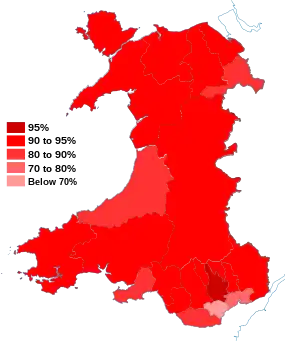
| Ethnic group | School year[45] | |||||
|---|---|---|---|---|---|---|
| 2008 | 2016 | 2022 | ||||
| Population | % | Population | % | Population | % | |
| White: Total | 383,820 | 93.8% | 362,290 | 92.2 | 365,231 | 90.3% |
| White: British | 376,870 | 92.1% | 351,145 | 89.4% | 350,842 | 86.7% |
| White: Irish Traveller/White Gypsy | 585 | 996 | 1,183 | 0.3% | ||
| White: Other | 6365 | 10,149 | 13,206 | 3.3% | ||
| Asian or Asian British: Total | 7,845 | 1.9% | 9,905 | 2.5% | 10,520 | 2.6% |
| Asian or Asian British: Indian | 1345 | 2,056 | 2,641 | 0.7% | ||
| Asian or Asian British: Pakistani | 2225 | 3,009 | 3,285 | 0.8% | ||
| Asian or Asian British: Bangladeshi | 2300 | 3,188 | 3,304 | 0.8% | ||
| Asian or Asian British: Chinese | 865 | 720 | 939 | 0.2% | ||
| Asian or Asian British: Asian Other | 1110 | 932 | 1,290 | 0.3% | ||
| Black or Black British: Total | 2,140 | 0.5% | 3,355 | 0.9% | 4,446 | 1.1% |
| Black or Black British: Caribbean | 200 | 194 | 198 | – | ||
| Black or Black British: African | 1595 | 2,743 | 3,711 | 0.9% | ||
| Black or Black British: Other | 345 | 418 | 537 | 0.1% | ||
| British Mixed: Total | 6,715 | 1.6% | 10,592 | 2.7% | 14,775 | 3.7% |
| Mixed: White and Caribbean | 1750 | 2,314 | 2,754 | 0.7% | ||
| Mixed: White and African | 730 | 1,398 | 2,198 | 0.5% | ||
| Mixed: White and Asian | 1605 | 2,351 | 3,011 | 0.7% | ||
| Mixed: Other Mixed | 2630 | 4,529 | 6,812 | 1.7% | ||
| Other: Total | 2530 | 0.6% | 4,639 | 1.2% | 6,059 | 1.5% |
| Other: Any other ethnic group | 2530 | 0.6% | 6,059 | 1.5% | ||
| Unknown or not stated | 6245 | 1.5% | 2,081 | 0.5% | 2,511 | 0.6% |
| Total: | 409,295 | 100% | 392,862 | 100% | 404,481 | 100% |
Religion
According to the 2011 census, there was a decrease of 14 percentage points in the number of Welsh residents describing themselves as Christian since 2001, when it had been cited by 2.1 million (72%) residents. Christianity experienced a significant decrease in numbers between 2001 and 2011 despite population growth.
The second largest response group for this question in 2011 was those identifying no religion. This increased from 538,000 (19%) of residents in 2001 to 983,000 (32%) in 2011, a larger rise than in any region of England.[32]
| Religion | 2001[46][47] | 2011[46][48] | ||
|---|---|---|---|---|
| Number | % | Number | % | |
| Christianity | 2,087,242 | 71.9 | 1,763,299 | 57.6 |
| No religion | 537,935 | 18.5 | 982,997 | 32.1 |
| Religion not stated | 234,143 | 8.1 | 233,928 | 7.6 |
| Islam | 21,739 | 0.7 | 45,950 | 1.5 |
| Other religion | 6,909 | 0.2 | 12,705 | 0.4 |
| Hinduism | 5,439 | 0.2 | 10,434 | 0.3 |
| Buddhism | 5,407 | 0.2 | 9,117 | 0.3 |
| Sikhism | 2,015 | 0.1 | 2,962 | 0.1 |
| Judaism | 2,256 | 0.1 | 2,064 | 0.1 |
| Total population | 2,903,085 | 100.0 | 3,063,456 | 100.0 |
- Based on pre-census 2011 sources. The largest single Christian denomination of Wales is Calvinist Methodism (Presbyterian Church of Wales), followed by the (Anglican) Church in Wales with 30% of the population, the Roman Catholic Church with 3% and the Congregationalist Union of Welsh Independents with 1% of the population.
Language
The 2011 census collected information about English and Welsh language proficiency. In 2011, 2.9 million (97%) of residents, age three and over, spoke English or Welsh. In a further 18,000 households, at least one adult spoke English or Welsh. In 22,000 households, no resident spoke either language. There were 562,000 (19%) residents, over age three, proficient in at least speaking the Welsh language. This was a reduction of approximately 2 per cent compared to 2001, though the method of analysis differed between the two censuses. There was also a 2% increase in those, over three years of age, who had no Welsh language skills.[32]
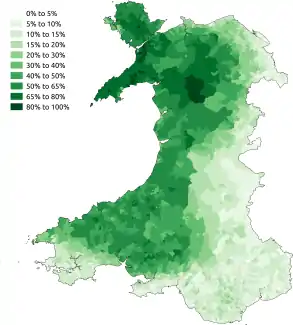
| Welsh language skills | 2001 number (,000) | 2001% | 2011 number (,000) | 2011% | change (,000) | change % |
|---|---|---|---|---|---|---|
| No skills in Welsh | 2,008 | 71.6 | 2,168 | 73.3 | 160 | 1.7 |
| Can speak, read and write Welsh | 458 | 16.3 | 431 | 14.6 | -27 | -1.7 |
| Can understand spoken Welsh only | 138 | 4.9 | 158 | 5.3 | 19 | 0.4 |
| Can speak but cannot read or write Welsh | 79 | 2.8 | 80 | 2.7 | 1 | -0.1 |
| Other combination of skills in Welsh | 84 | 3.0 | 73 | 2.5 | -10 | -0.5 |
| Can speak and read but cannot write Welsh | 38 | 1.4 | 46 | 1.5 | 7 | 0.1 |
- Source: 2011 Census: KS207WA Welsh language skills, unitary authorities in Wales, Accessed 23 December 2012
The most common main languages spoken in Wales according to the 2011 census are shown below.[49]
| Language | Usual residents aged 3+ | Proportion |
|---|---|---|
| English or Welsh | 2,871,405 | 97.14% |
| Polish | 17,001 | 0.58% |
| Arabic | 6,800 | 0.23% |
| Bengali (with Sylheti and Chatgaya) | 5,207 | 0.18% |
| Tagalog/Filipino | 2,749 | 0.09% |
| Portuguese | 2,451 | 0.08% |
| Urdu | 2,350 | 0.08% |
| French | 2,073 | 0.07% |
| German | 2,050 | 0.07% |
| Italian | 1,694 | 0.06% |
| Other | 42,061 | 1.42% |
Marriage and civil partnership
In 2011 those who were married were still the largest marriage / civil partnership status group in Wales for residents aged 16 and over though since 2001 this group has decreased by 37,000 (over 5%). In contrast, single people (i.e. those who have never married or been part of a same sex partnership), have increased by 190,000 (6%) in the ten-year period. Civil partnerships, which were given legal status in 2005, appear for the first time in the census results. The number of widows, widowers and surviving partners is 20,000 lower than in 2001. The final groups, relating to separation and divorce / legal dissolution of civil partnerships, have both seen an increase in both numerical and relative terms since 2001.[32]
| Status | 2001 number (,000) | 2001% | 2011 number (,000) | 2011% |
|---|---|---|---|---|
| Married | 1,204 | 52.0 | 1,167 | 46.6 |
| Single | 650 | 28.1 | 840 | 33.5 |
| Divorced / legally dissolved | 201 | 8.7 | 242 | 9.7 |
| Widowed or surviving partner | 218 | 9.4 | 198 | 7.9 |
| Separated | 44 | 1.9 | 55 | 2.2 |
| Civil partnership | n/a | n/a | 5 | 0.2 |
Table key
- Single = Single never married or registered a same-sex civil partnership)
- Divorced / legally dissolved = divorced or formerly in a same-sex civil partnership which is now legally dissolved
- Widowed or surviving partner = Widowed or surviving partner from a same-sex civil partnership
- Separated = Separated (but still legally married or still legally in a same-sex civil partnership)
- Civil partnership = In a registered same-sex civil partnership
Military staff and veterans
Out of the armed services, the Army has the largest presence in Wales, with over 1,400 personnel based there. As of 2019, there were 3,230 military and civilian personnel based in Wales.[50]
In the 2021 census, around 115,000 people in Wales reported that they had previously served in the armed forces, around 4.5% of usual residents in Wales aged 16 years or older.[51]
Miscellaneous data
- Population density (2006): 143 people per square kilometre[52]
- Fertility rate: 1.90 (2007)[53]
- In 2010, 58% of births were outside marriage in Wales.[54] Currently, Wales and Scotland are the only countries of the United Kingdom where the majority of births are outside of marriage (51.3% of births in Scotland in 2012 were outside of marriage).[55] Wales (along with Scotland) also had the highest death rate (10.9 per thousand) in 2005.[56]
See also
References
- ↑ "200 years of the Census in Wales" (PDF). Gov.uk. Archived from the original (PDF) on 2009-03-19. Retrieved 21 October 2017.
- ↑ "Population estimates". Office for National Statistics. Retrieved 21 October 2017.
- ↑ John Davies (1993). A History of Wales. pp. 258–59, 319. ISBN 9780141926339.
- ↑ 200 Years of the Census in ... Wales (2001)
- ↑ Brian R. Mitchell and Phyllis Deane, Abstract of British Historical Statistics (Cambridge, 1962) pp 20, 22
- ↑ "2021 Census - Population and household estimates, Wales - Office for National Statistics". www.ons.gov.uk. Retrieved 2022-07-22.
- ↑ "2011 Census – Population and Household Estimates for Wales" (PDF). Office for National Statistics. March 2011. p. 6. Retrieved 13 December 2012.
- ↑ "O2011 Census: Key Statistics for Wales, March 2011". Ons.gov.uk. March 2011. Retrieved 9 January 2016.
- ↑ "O2011 Census: Key Statistics for Wales, March 2011". Ons.gov.uk. March 2011. Retrieved 15 January 2016.
- ↑ "A Statistical Focus on Ethnicity in Wales" (PDF). National Assembly for Wales. 2004. p. 1. Archived from the original (PDF) on 14 December 2011. Retrieved 10 February 2012.
- ↑ Davies (2008) p. 391
- ↑ Turner, Robin (8 January 2004). "Poles immigrate to Welsh town by thousands". Western Mail. WalesOnline. Retrieved 25 November 2010.
- ↑ Ford, Richard (12 October 2007). "Break out the golabki as Polish workers spread across map of Britain". The Times. London: TimesOnline. Retrieved 25 November 2010.
- ↑ "Census results 'defy tickbox row'". BBC Online. Retrieved 23 February 2014.
- ↑ "2011 Census: KS202EW National identity, unitary authorities in Wales (Excel sheet 126Kb)". Office for National Statistics. 11 December 2012. p. 3. Retrieved 28 September 2013.
- ↑ "Nationalia – Two out of three inhabitants of Wales consider Welsh to be their national identity". Retrieved 7 October 2014.
- 1 2 2011 Census: First Results for Ethnicity, National Identity, and Religion for Wales (PDF), Welsh Government, 2012, archived from the original (PDF) on 24 December 2012, retrieved 6 March 2014
- ↑ "ONS, "Ethnicity and National Identity in England and Wales 2011", 2012, p.8" (PDF).
- ↑ "2011 Census: KS201EW Ethnic group, local authorities in England and Wales". Office for National Statistics. Retrieved 28 February 2014.
- ↑ "Use of the census of population to discern trends in the Welsh language: an aggregate analysis" (PDF). Office for National Statistics. 8 January 2004. Archived from the original (PDF) on 8 March 2012. Retrieved 10 February 2012.
- ↑ "Profile of General Demographic Characteristics: 2000" (PDF). United States Census Bureau. July 2002. Retrieved 2 October 2010.
- ↑ "Ethnic origins, 2006 counts, for Canada, provinces and territories – 20% sample data". Statistics Canada. 8 January 2004. Retrieved 19 June 2010.
- ↑ "Total Fertility Rate and General Fertility Rate by year". Statswales.wales.gov.uk. Retrieved 17 July 2013.
- ↑ "Live births by year, marriage, parity and registration type". Statswales.wales.gov.uk. Retrieved 17 July 2013.
- ↑ "One in 10 Welsh babies have foreign-born mothers". BBC News. 31 August 2012.
- ↑ "Mid-Year Population Estimates, UK, June 2021". Office for National Statistics. 21 December 2022. Retrieved 18 October 2023.
- ↑ "Vital Statistics: Population and Health Reference Tables". Office for National Statistics. Retrieved 20 July 2017.
- ↑ "Provisional births in England and Wales".
- ↑ "Deaths registered monthly in England and Wales".
- ↑ "O2011 Census: Key Statistics for Wales, March 2011". Ons.gov.uk. March 2011. Retrieved 9 January 2016.
- ↑ "Census 2001 Key Statistics - Local Authorities KS05 Country of birth" (XLS). Ons.gov.uk. Retrieved 6 September 2014.
- 1 2 3 4 5 6 "2011 Census: Key Statistics for Wales, March 2011" (PDF). Ons.gov.uk. Retrieved 23 December 2012.
- ↑ "Table 1.3: Overseas-born population in the United Kingdom, excluding some residents in communal establishments, by sex, by country of birth, January 2014 to December 2014". Office for National Statistics. 27 August 2015. Retrieved 17 April 2016. Figures given are the central estimates. See the source for 95 per cent confidence intervals.
- ↑ Harries, Bethan; Byrne, Bridget; Lymperopoulou, Kitty (November 2014). "who identifies as Welsh? National identities and ethnicity in Wales" (PDF). Centre on Dynamics of Ethnicity (CoDE) / University of Manchester. Retrieved 29 July 2019.
- ↑ Davies, Daniel. "How optimistic are people in Wales, BBC survey asks". BBC News. Retrieved 29 July 2019.
- ↑ "YouGov / BBC Survey Results" (PDF). www.yougov.co.uk. 2018. Retrieved 29 July 2019.
- ↑ "YouGov - UK break up attitudes (Wales)" (PDF).
- ↑ https://www.gov.wales/ethnic-group-national-identity-language-and-religion-wales-census-2021-html
- ↑ "Ethnic minorities in Britain: statistical information on the pattern of settlement". Commission for Racial Equality: Table 2.1. 1985.
- ↑ Office of Population Censuses and Surveys ; General Register Office for Scotland ; Registrar General for Northern Ireland (1997): 1991 Census aggregate data. UK Data Service (Edition: 1997). DOI: http://dx.doi.org/10.5257/census/aggregate-1991-1 This information is licensed under the terms of the Open Government Licence
- ↑ As UK Census data past 2001 is unavailable through the ONS website, it has been recommended to use archival census collection websites to obtain data. Data is taken from United Kingdom Casweb Data services of the United Kingdom 1991 Census on Ethnic Data for Wales (Table 6)
- ↑ "Ethnic Statistics in Unitary authorities in Wales". webarchive.nationalarchives.gov.uk. Archived from the original on 2022-01-07. Retrieved 2022-01-07.
- ↑ "Key Statistics for Unitary authorities in Wales". webarchive.nationalarchives.gov.uk. Archived from the original on 2022-01-07. Retrieved 2022-01-07.
- ↑ "Ethnic group - Office for National Statistics". www.ons.gov.uk. Retrieved 2022-11-29.
- ↑ "Schools' census results: February 2022". GOV.WALES. Retrieved 2022-11-04.
- 1 2 "2011 Census: Key Statistics for Wales, March 2011". Office for National Statistics. Retrieved 15 December 2012.
- ↑ "Religion (2001 Census)". Data.gov.uk. 9 February 2010. Retrieved 17 December 2012.
- ↑ "2011 Census: KS209EW Religion, local authorities in England and Wales". Office for National Statistics. Retrieved 15 December 2012.
- ↑ "View:Wales". NOMIS. Retrieved 5 September 2014.
- ↑ Zubova, Xenia. "How Welsh is the British Army?". Forces Network. Retrieved 2022-04-26.
- ↑ "UK Armed Forces veterans in Wales (Census 2021)". GOV.WALES. Retrieved 2022-11-19.
- ↑ "Stats Wales". Statwales.wales.gov.uk. Retrieved 2017-08-29.
- ↑ "Live births by local authority 2007". Statistics.gov.uk. Archived from the original on 2007-07-06. Retrieved 2017-08-29.
- ↑ "Detailed official data on Wales". Statwales.wales.gov.uk. Retrieved 2017-08-29.
- ↑ "Archived copy" (PDF). Archived from the original (PDF) on 2013-06-17. Retrieved 2013-04-17.
{{cite web}}: CS1 maint: archived copy as title (link) - ↑ "Wales's Population: A Demographic Overview 1971-2005" (PDF). New.wales.gov.uk. Archived from the original (PDF) on 2008-07-19. Retrieved 2017-08-29.